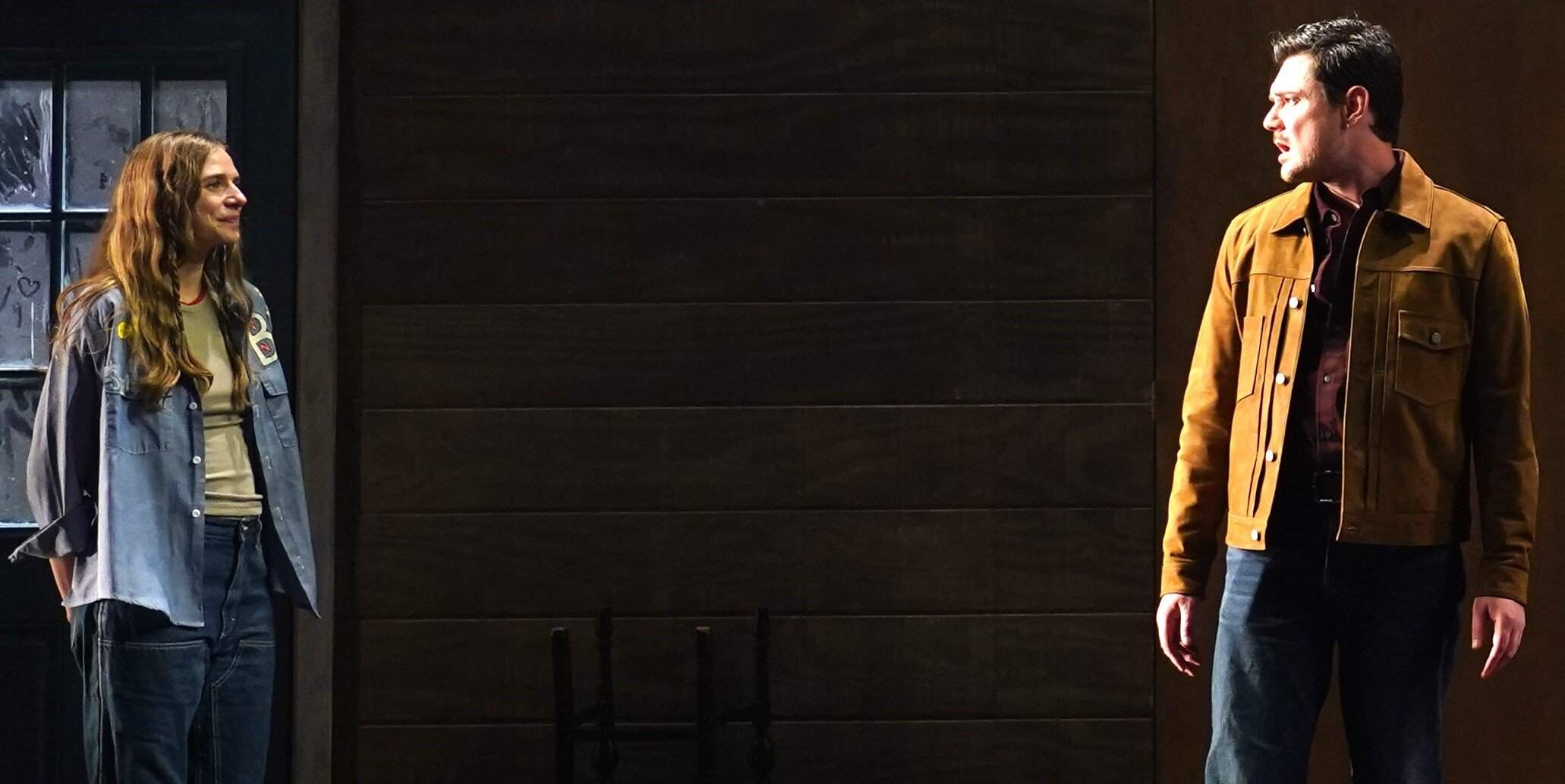Will (Tom Pecinka, right) has come to the commune where Gracie (Cricket Brown) is a resident in search of his missing brother, Peter (who is also portrayed by Pecinka), in Anne Washburn’s new play, The Burning Cauldron of Fiery Fire.
Anne Washburn’s The Burning Cauldron of Fiery Fire, making its world premiere at the Vineyard Theatre, defies categorization. The offbeat exploration of an agrarian California commune bordering on a cult might also defy comprehension; your mileage may vary depending on your tolerance for unknowable mysteries. There is something mesmerizing about Burning Cauldron, beautifully strange and compelling, with silliness and menace existing so comfortably side by side. Who needs easy answers when the questions are this much fun?
Each of the eight ensemble members plays at least two roles—an adult commune resident and a child—as well as joining the chorus, which sets the scenes by reciting physical details of the surroundings in a trance-like state (Lisa Fagan’s movement coordination is especially effective in these moments). Though ostensibly an egalitarian place, Thomas (a terrific Bruce McKenzie) is the commune’s de facto leader, or at least the one most insistent about imposing his will and vision on the group, despite occasional pushback from his partner, Mari (Marianne Rendón).
Will’s interests go beyond finding his brother, and include Mari (Marianne Rendón). Photographs by Carol Rosegg.
Andrew Boyce’s rustic communal kitchen and dining area (which transforms into other locations via Amith Chandrashaker’s excellent lighting design), Emily Rebholz’s costume design, and Tommy Kurzman’s wig and hair design all capture Washburn’s note in the script that “The adults look, well, kind of like hippies.”
Washburn also notes that “Not a moment of this should be played for satire,” and director Steve Cosson—who helmed Washburn’s acclaimed 2013 Mr. Burns, A Post-Electric Play—has heeded this, which prevents the play from becoming just another send-up of hippie culture. The contradictions and hypocrisies of the commune life are on display, but ultimately there are more ineffable forces at work.
The play’s inciting incident is the death of Peter (Tom Pecinka), who has been at the commune for less than a year and seems to have taken his own life, though apparently with no note left behind. This puzzles his comrades, particularly Gracie (Cricket Brown): “Peter loved his self expression it doesn’t seem like him to pass up that kind of captive audience.” One can see here the often-unpunctuated style of Washburn’s dialogue, a challenge that all the actors have ably met, as they achieve convincing and precise characterizations.
The group selfishly and callously decides to hide Peter’s death and tell his family, if they reach out, that he simply left. Burning the body doesn’t go as planned—“He’s too clumpy to scatter”—so they decide to bury the remains deep, with no marker. For their part, the children decide that Peter has been reincarnated as a piglet born of the beloved sow Lula.
Peter’s mother does call to check in on him, leading to an eruption by Thomas to abolish their telephone: “This is a gate from anywhere what good is it to be away from all that crap all of that mental pollution when a box can start talking to me any kind of a way smack in the middle of my home.” But more problematically for the group, Peter’s brother Will (also played by Pecinka, now sans long-haired wig) arrives in search of him.
“Each of the eight ensemble members plays at least two roles—an adult commune resident and a child—as well as joining the chorus.”
Will’s own motives aren’t as straightforward as they first appear; some of them are explained and some only hinted at. Will is regaled by a play written by Peter with the children. In the fairy-tale play, Peter (here played by Bartley Booz, who also plays commune residents Paul and the near-catatonic Ghazal) vies for the love of a princess against nefarious plots orchestrated by her cruel father.
This includes Peter immersing himself in a cauldron of fire, inhabited by fire fishes, and coming back to life when a hen gives birth to a giant egg (puppet design by Monkey Boys Productions). Just as Peter is about to confront a dragon, the play within the play ends, because that’s as far as they got.
At first the fairy-tale seems like an amusing diversion from the main story, but Washburn has crafted an intriguingly perplexing and visually stunning ending that reincorporates elements from Peter’s play and turns reality upside-down. Does it all add up in some literal way? If so, I couldn’t connect all the dots. Instead, I had an experience akin to watching a David Lynch film: that there isn’t one precise answer, but rather a series of lasting and haunting impressions.
Washburn’s play burns brightly, if enigmatically, and its glow lingers long after the lights go down.
The Burning Cauldron of Fiery Fire runs through Nov. 30 at the Vineyard Theatre (108 E. 15th St.). Evening performances are 7 p.m. Tuesday through Saturday; matinees are at 2 p.m. Saturday and Sunday. For tickets, visit vineyardtheatre.org.
Playwright: Anne Washburn
Director: Steve Cosson
Scenic Design: Andrew Boyce
Costume Design: Emily Rebholz
Lighting Design: Amith Chandrashaker
Sound Design: Ryan Gamblin
Puppet Design: Monkey Boys Productions




